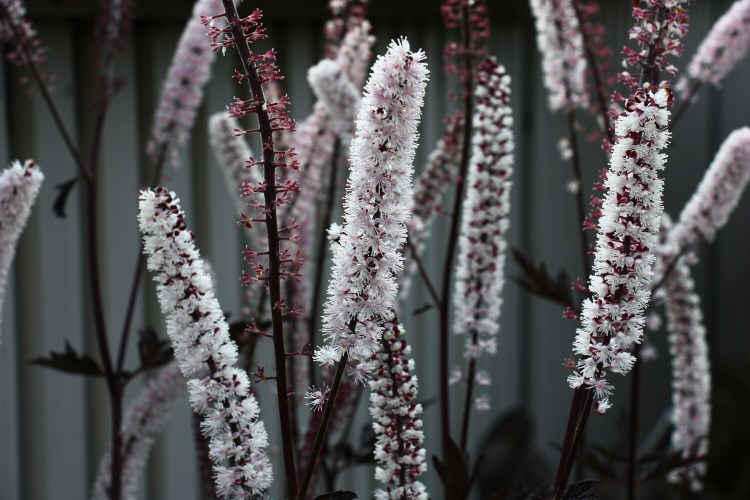People always want more late-blooming plants in their gardens. Rather, I do, and I am self-centered enough to believe that many people agree with me.
Gardeners typically do most of their plant-shopping in the spring, and they buy what is in bloom because it looks best. To add more late-bloomers, they also should shop for plants in late summer and fall and see the plants that are in bloom at that time.
The plants that I’m going to cover today aren’t the ones most people think of first. These are a bit less common. So, except for right here, this column will not include daylilies, goldenrod, helenium, Joe Pye weed, monarda, sedum, rudbeckia, echinacea, asters, hibiscus or asclepias. All great plants. If you have forgotten what I wrote about them last year in a column on this same subject, go online and read it again.
Cimicifuga (the botanical name has been changed to Actaea, according to some plant geeks) is one of my favorite plants, and I am surprised and slightly ashamed that I didn’t mention it in my column last year.
There are many varieties, most are native, which grow as tall as seven feet or as short as three feet; the flower spikes alone get to be as much as a foot long. The flowers are usually white, though some have a pink tinge. Some cultivars have almost black or dark purple foliage, others have dark green foliage.
Pollinators love Cimicifuga. The catalogs say it’s a butterfly magnet. I don’t know about that, but there are dozens of bumblebees on ours as I write this column, taking advantage of the breeze on our patio.
All will take a bit of shade, some will take full shade. They require minimal care, making the plant a lot of beauty for a little effort.
Agastache is another U.S. native (mostly Northern Midwest) that I love, as much for its licorice-like fragrance as its blue-violet blossoms, which last from summer until frost. Varieties range from 16 inches to three feet tall, and Agastache will grow in full sun or part shade. It prefers sandy soils.
This plant provides a lot of nectar for pollinators, and deer will absolutely avoid it.
Coreopsis is another species that includes late – and long-blooming – flowers. There are also spring-blooming varieties, so be sure you know what you are buying.
My personal favorite is one that grows between our driveway and vegetable garden. My wife, Nancy, bought seeds for it decades ago from the American Horticultural Society and isn’t sure of the variety, but it took to our property and has thrived. It grows six to seven feet tall and in September is covered with yellow flowers.
From pictures and descriptions I found online at the Lady Bird Johnson Wildflower Center database, I think it may be Coreopsis tripteris (tall tickseed) or a close relative. The database includes some online sources for seeds and seedlings, none of which are familiar to me.
We have other, shorter varieties of coreopsis that also bloom well into fall, and local nurseries have many cultivars.
Anemones are another perennial that provides good late color (don’t confuse them with the fall-planted, spring-blooming anemone bulbs). The cultivar “Honorine Jobert” grows three feet tall. Its flowers are white and two to three inches across with yellow stamens. In 2016, it was the Perennial Plant of the Year. Other anemone cultivars offer rose and pink flowers.
Chelone, or turtlehead, also grows well for us. The native species plant is white with deep green foliage, but some cultivars come with darker foliage or pink flowers. It is a subtle plant, growing up to three feet tall. It gets its common name from the stance of the bloom, which resembles a turtle poking its head out of its shell.
Another late bloomer is boltonia, which produces huge clouds of white golden-eyed flowers on three-foot tall plants. Late in the season, it is one of the focal points in our back yard. It blossoms well in the full shade of our neighbor’s Norway maples. The catalog says it will also take full sun, but we have not tried it there. Boltonia has many blooms per stem, which is good because each bloom is smaller than a dime. Then again, their small size, taken en masse, adds to the cloud-like affect.

Dahlias are a bit of trouble in Maine. So worth it. Staff Photo by Doug Jones
Finally, I’m going to mention dahlias. We grow them as cut flowers in the vegetable garden, but a friend grows them in her ornamental gardens just like they are perennials – although in our climate, you’ll need to dig them in the fall and store them over the winter. Still, any plant that has gorgeously bright blossoms in a variety of colors from mid-July to the first frost is worth the extra work.
Tom Atwell is a freelance writer gardening in Cape Elizabeth. He can be contacted at: tomatwell@me.com
Send questions/comments to the editors.


